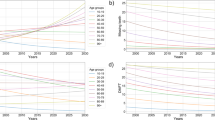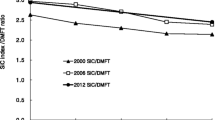Abstract
Caries in permanent teeth is still the most prevalent disease worldwide. However, there are numerous reports about a caries decline with respect to caries prevalence and caries experience (DMFT or dmft scores). The most pronounced caries decline has been noticed in 12-year-old children in industrialized countries. These reports might obstruct the view on the epidemiological caries development in the primary dentition, which is not as successful as in the permanent dentition. Regarding the age groups of 3-year-old or even younger children, there are only limited data. These data show considerable differences in caries prevalence, but consistently a caries decline, even of widely varying magnitude. In 5- to 7-year-old children there is indeed an obvious trend for a caries decline over the last decades. However, this decline is only weak since around the year 2000, and in some countries there are indications for a halt or even a reversal of the caries decline in the primary dentition in this age group. The data for 12-year-old children demonstrate a distinct caries decline, which has continued through all last decades and reached DMFT values of 0.5 or less in some countries. However, parallel to the caries decline, there is an increasingly stronger caries polarization. Analytical caries epidemiology provides strong indications for an enhancement of the caries decline by placing fissure sealants. This effect seems to be particularly important in children with low SES background who benefit from this caries preventive measure to higher extents than other children.
Access this chapter
Tax calculation will be finalised at checkout
Purchases are for personal use only
Similar content being viewed by others
References
Kassebaum NJ, Bernabé E, Dahiya M, Bhandari B, Murray CJL, Marcenes W. Global burden of untreated caries. J Dent Res. 2015;94:650–8.
Schiffner U. Epidemiology of caries and noncarious defects. In: Meyer-Lückel H, Paris S, Ekstrand K, editors. Caries management – science and clinical practice. Stuttgart: Thieme; 2013. p. 118–32.
World Health Organization. Oral health surveys: basic methods. Geneva: World Health Organization; 2013.
Pitts NB. Diagnostic tools and measurements – impact on appropriate care. Community Dent Health. 1992;10:1–9.
Country/Area Profile Project (CAPP). Country oral health profiles. https://www.mah.se/CAPP/Country-Oral-Health-Profiles/. Accessed 24 April 2017.
Organisation for Economic Co-operation and Development (OECD) Health Status: Dental health. 2016. https://stats.oecd.org/index.aspx?DataSetCode=HEALTH_STAT. Accessed 2 May 2017.
Treuner A, Splieth C. Frühkindliche Karies – Fakten und Prävention. Zahnarztl Mitt. 2013;103(17):44–50. http://www.zm-online.de/hefte/Fruehkindliche-Karies-Fakten-und-Praevention_139858.html#1. Accessed 27 April 2017.
Ha DH, Roberts-Thomson KF, Arrow P, Peres KG, Do LG. Children’s oral health status in Australia, 2012–14. In: Do LG, Spencer AJ, editors. Oral health of Australian children: The National Child Oral Health Study 2012–14. Adelaide: University of Adelaide Press; 2016. p. 86–152. www.adelaide.edu.au/press. Accessed 2 May 2017.
Malmö University Global DMFT for 12-year-olds: 2015. 2015. https://www.mah.se/CAPP/Country-Oral-Health-Profiles/According-to-Alphabetical/Global-DMFT-for-12-year-olds-2011/. Accessed 2 May 2017.
Australian Institute of Health and Welfare. Oral health and dental care in Australia - Key facts and figures 2015. Canberra, Cat. no. DEN 229. 2016. http://www.aihw.gov.au/WorkArea/DownloadAsset.aspx?id=60129554609. Accessed 28 April 2017.
Schiffner U. Krankheits- und Versorgungsprävalenzen bei Kindern (12-Jährige): Karies, Erosionen, Molaren-Inzisiven-Hypomineralisationen. In: Jordan AR, Micheelis W, editors. Fünfte Deutsche Mundgesundheits-Studie (DMS V). Cologne: Deutscher Ärzte-Verlag; 2016. p. 231–68.
Pieper K. Epidemiologische Begleituntersuchungen zur Gruppenprophylaxe 2009. DAJ [Deutsche Arbeitsgemeinschaft für Jugendzahnpflege], Bonn; 2010.
Truin GJ, König KG, Bronkhorst EM, Frankenmolen F, Mulder J, van’t Hof MA. Time trends in caries experience of 6- and 12-year-old children of different socioeconomic status in The Hague. Caries Res. 1998;32:1–4.
Burt BA, Eklund SA. Dentistry, dental practice and the community. 6th ed. St. Louis: Elsevier Saunders; 2005.
Schwendicke F, Dörfer CE, Schlattmann P, Foster Page L, Thomson WM, Paris S. Socioeconomic inequality and caries: a systematic review and meta-analysis. J Dent Res. 2015;94:10–8.
Griffin SO, Wei L, Gooch BF, Weno K, Espinoza L. Vital signs: dental sealant use and untreated tooth decay among U.S. school-aged children. MMWR Morb Mortal Wkly Rep. 2016;65:1141–5.
Author information
Authors and Affiliations
Corresponding author
Editor information
Editors and Affiliations
Rights and permissions
Copyright information
© 2018 Springer International Publishing Switzerland
About this chapter
Cite this chapter
Schiffner, U. (2018). Trends in Caries Epidemiology in Children. In: Bekes, K. (eds) Pit and Fissure Sealants. Springer, Cham. https://doi.org/10.1007/978-3-319-71979-5_1
Download citation
DOI: https://doi.org/10.1007/978-3-319-71979-5_1
Published:
Publisher Name: Springer, Cham
Print ISBN: 978-3-319-71978-8
Online ISBN: 978-3-319-71979-5
eBook Packages: MedicineMedicine (R0)




